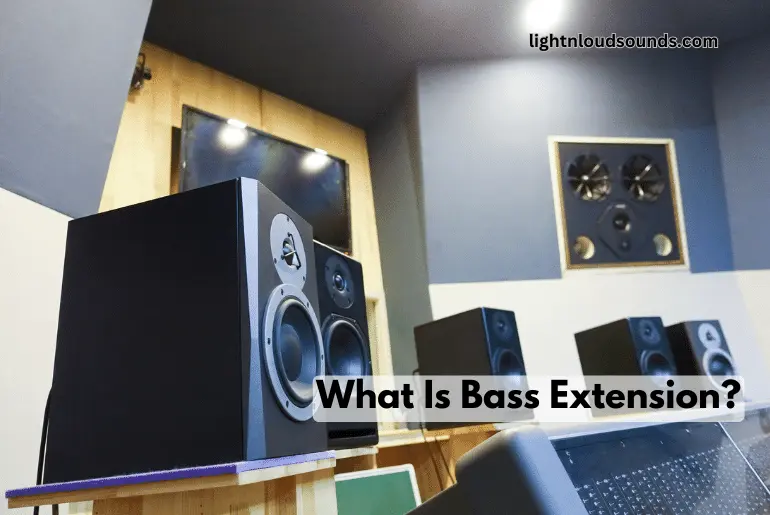Bass is the backbone of many musical genres and audio experiences. These deep, low-frequency sounds offer a foundation, adding depth, warmth, and a tangible feel to the music and soundscapes. Whether it’s the resonant pulse in a classical piece, the thumping beat of electronic music, or the subtle ambiance in a movie scene, bass plays an instrumental role.
Yet, there’s more to bass than just its presence; the depth to which it can reach is equally significant. This post will discuss bass extension and its importance for optimal sound quality.
Post Contents
What Is Bass Extension?
Bass extension is the lowest frequency that a speaker or audio system can reproduce accurately. It is measured in hertz (Hz). A lower number indicates that the speaker can produce deeper bass sounds.
Bass extension is important for a number of reasons. First, it helps to create a more immersive listening experience. When you can hear the deep bass notes, it makes the music sound more full and powerful. Also, bass extension can help to improve the clarity of the sound. When the bass is not being reproduced accurately, it can muddy the sound and make it difficult to hear the other instruments.
Factors Affecting Bass Extension
1. Speaker/headphone design
Every speaker or headphone is designed with certain goals in mind. The size, shape, and materials used can influence how well the device reproduces bass sounds.
For instance, a headphone with larger ear cups might have more space to generate deeper bass compared to compact in-ear models. Similarly, the materials used, such as the type of foam or plastic, can affect how sound resonates within the device.
2. Driver size and material
The driver is the component inside a speaker or headphone that converts electrical signals into sound. Generally, bigger drivers can move more air, leading to deeper bass. However, it’s not just about size.
The material of the driver, be it paper, plastic, or metal, can also influence the quality and depth of the bass. A well-designed smaller driver can sometimes outperform a larger, poorly designed one.
3. Enclosure design
The enclosure or casing around a speaker plays a significant role in bass production. There are different designs, like sealed and ported.
A sealed enclosure is air-tight, offering tighter bass control. In contrast, a ported design has openings that allow air to move, often resulting in more pronounced and deeper bass. Each has its advantages and is suited for different audio preferences.
4. Amplification and power handling
The power behind your audio device also affects bass extension. More power can push the driver to produce deeper and louder bass. However, it’s not as simple as “more power equals better bass.”
The speaker or headphone needs to handle that power efficiently without distorting the sound. It’s a delicate balance between providing enough power and ensuring the device uses it effectively.
5. Position of the speaker
The position of the speaker can also affect bass extension. Speakers placed close to a wall or other hard surface will have better bass extension than speakers placed in the middle of a room. This is because the wall or hard surface will reflect the sound waves and help to amplify them.
Tips for Enhancing Your Speaker’s Bass Extension

1. Position your speakers properly
Where you place your speakers can make a significant difference in bass performance. Corners can amplify bass due to sound waves reflecting and reinforcing each other. However, this can sometimes muddy the sound. Experiment with different placements. Sometimes, moving a speaker a few inches can drastically improve bass clarity and depth.
2. Choosing the right speaker or headphone
Not all audio devices are made equal. Some are designed with a focus on treble clarity, while others might emphasize bass depth. When shopping, look for specifications related to bass response or ask for recommendations based on your listening preferences.
3. Subwoofers can extending bass response
A subwoofer is specifically designed to reproduce the lowest frequencies. If you’re finding your audio setup lacks that deep rumble, adding a subwoofer can make a world of difference. It takes on the heavy lifting of producing the deepest sounds, allowing other speakers to focus on mid and high frequencies, which can result in a clearer and more balanced audio experience.
4. Room acoustics and treatments to consider:
The environment plays a pivotal role in how we perceive sound. Bare walls can reflect sound waves, leading to unwanted echoes or making bass sound boomy.
Adding soft materials like rugs, curtains, or acoustic panels can absorb some of these reflections, improving the overall sound quality. For those serious about their audio, dedicated bass traps can be placed in corners to further enhance bass performance.
Conclusion
Bass extension is an important factor to consider when choosing speakers or setting up an audio system. It adds depth and fullness to sounds. While various factors influence how we perceive bass, understanding and optimizing these elements can greatly enhance our listening pleasure.
By understanding what bass extension is and how it affects sound quality, you can make sure that your system is capable of producing the deep, rich bass that you want.

